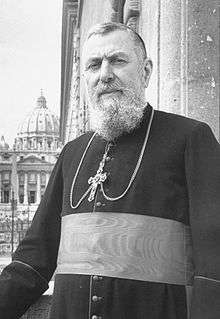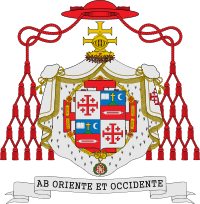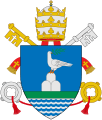Eugène Tisserant
| His Eminence Eugène Tisserant | |
|---|---|
| Dean of the College of Cardinals | |
 Cardinal Tisserant in 1958 | |
| Appointed | 13 January 1951 |
| Term ended | 21 February 1972 |
| Predecessor | Francesco Marchetti Selvaggiani |
| Successor | Amleto Giovanni Cicognani |
| Other posts |
|
| Orders | |
| Ordination |
4 August 1907 by Charles-François Turinaz |
| Consecration |
25 July 1937 by Eugenio Pacelli |
| Created Cardinal |
15 June 1936 by Pius XI |
| Rank | Cardinal Bishop |
| Personal details | |
| Birth name | Eugène Gabriel Gervais Laurent Tisserant |
| Born |
24 March 1884 Nancy, France |
| Died |
21 February 1972 (aged 87) Albano Laziale, Province of Rome, Italy |
| Nationality | French |
| Denomination | Roman Catholic |
| Previous post |
|
| Styles of Eugène Tisserant | |
|---|---|
 | |
| Reference style | His Eminence |
| Spoken style | Your Eminence |
| Informal style | Cardinal |
| See |
Porto e Santa Rufina (suburbicarian), Ostia (suburbicarian) |
Eugène-Gabriel-Gervais-Laurent Tisserant[1] (24 March 1884 – 21 February 1972) was a French prelate and Cardinal of the Roman Catholic Church. Elevated to the cardinalate in 1936, Tisserant was a prominent and long-time member of the Roman Curia.
Biography
Early years and ordination
Eugène Tisserant was born in Nancy to Hippolyte and Octavée (née Connard) Tisserant. From 1900 to 1904, he studied theology, Sacred Scripture, Hebrew, Syriac, Old Testament, and Oriental Patrology at the seminary in Nancy. He was reportedly fluent in thirteen languages: Amharic, Arabic, Akkadian, English, French, German, Greek, Hebrew, Italian, Latin, Persian, Russian, Syriac.[2] He then studied in Jerusalem under Marie-Joseph Lagrange, O.P., but returned to France in 1905 for military service.
On 4 August 1907, Tisserant was ordained a priest by Charles-François Turinaz, Bishop of Nancy.
Professor and prelate
Tisserant served as a professor at the Pontifical Roman Athenaeum S. Apollinare and curator at the Vatican Library from 1908 to 1914, at which time he became an intelligence officer in the French Army during World War I. Named assistant librarian of the Vatican Library in 1919 and Monsignor in 1921, Tisserant became Pro-Prefect of the Vatican Library on 15 November 1930 and was named a protonotary apostolic on 13 January 1936.
Cardinal and curial appointments
In the consistory of 15 June 1936, Tisserant was created Cardinal Deacon by Pope Pius XI, assigned as his titular church the Basilica of Santi Vito, Modesto e Crescenzia. He was raised to the rank of Cardinal Priest soon afterwards, retaining the same title.
On 25 June 1937, Tisserant was appointed the Titular Archbishop of Iconium by Pope Pius XI. he received his consecration on the following 25 July from Cardinal Eugenio Pacelli (later Pope Pius XII), with Archbishop Giuseppe Migone and Bishop Charles-Joseph-Eugène Ruch serving as co-consecrators, in St. Peter's Basilica. He participated in the conclave of 1939, which elected Pacelli as Pope Pius XII. With the new pontiff's permission, he switched from his titular church to that of Santa Maria sopra Minerva.
Tisserant held a number of offices in the Roman Curia. He served as Secretary of the Congregation for the Oriental Churches (1936-1959), as President of the Pontifical Biblical Commission (1938–1946) and as Prefect of the Congregation of Ceremonies (1951-1967) until the latter congregation was divided into the Congregation for the Causes of Saints and that of Divine Worship). From 1957 to 1971, he served as Librarian and Archivist of the Holy Roman Church. Under Pius XII, Tisserant also headed a tribunal to investigate alleged abuses of Knights Hospitaller appointments, which concluded that there was no wrongdoing.[2]
In 1939, the French prelate urged Pius XII to promulgate an encyclical "on the duty of Catholics to resist the unjust orders of an authoritarian state."[3] After the outbreak of World War II, Pius XII refused to release Tisserant as the head of the Vatican Library, so that Tisserant could return to France to serve in the army.[2]
In 1946 Tisserant was elevated to the rank of Cardinal Bishop by Pope Pius, taking the title of Porto e Santa Rufina in 1946. After serving as vice-dean of the College of Cardinals from 1947 to 1951, he became Dean and Cardinal Bishop of Ostia on 13 January 1951. As Dean of the Sacred College, he presided at the Funeral Masses of Popes Pius XII and John XXIII and presided over the conclaves to elect their successors in the conclaves of 1958 and 1963. During the 1958 conclave, he was seen as papabile by most Vatican-watchers, and it is generally believed that he received at least five votes in the early balloting.[4]
In 1961 Tisserant was elected a member of the Académie française. Doctor «honoris causa» in Coimbra University (1956).
Second Vatican Council and beyond
From 1962 to 1965, Tisserant attended the Second Vatican Council and sat on its Board of Presidency. He is said to have participated in negotiating a secret 1960s agreement between Soviet and Vatican officials that authorized Eastern Orthodox participation in the Second Vatican Council in exchange for a non-condemnation of atheistic communism during the conciliar assemblies.[5][6] As Dean of the Sacred College, he was the first person after Pope Paul VI to sign each of the acts of the Second Vatican Council.
In 1962 Tisserant became Grand Master of the Order of the Holy Sepulchre, a position he held until his death.
In 1969 an example of the split within the hierarchy came into view when Tisserant demanded a retraction from Cardinal Leo Joseph Suenens, Archbishop of Brussels-Mechelen, for the "defamatory and slanderous" statements he allegedly made against the bureaucracy of the Roman Curia.[4]
Death
Tisserant died in 1972 from a heart attack in Albano Laziale, at age 87. He is buried in the Basilica of Porto e Santa Rufina in Rome.[7]
Episcopal succession
| Ordination history of Eugène Tisserant | |
|---|---|
Priestly ordination | |
| Ordained by | Charles-François Turinaz (Nancy) |
| Date of ordination | 4 August 1907 |
Episcopal consecration | |
| Principal consecrator | Eugenio Card Pacelli (Gio & Pao) |
| Co-consecrators |
Giuseppe Migone (Nicomedia tit) Charles Ruch (Strasbourg) |
| Date of consecration | 25 July 1937 |
Cardinalate | |
| Elevated by | Pius XI |
| Date of elevation | 15 June 1936 |
Bishops consecrated by Eugène Tisserant as principal consecrator | |
| Alberto Gori | 27 December 1949 |
| Sebastian Vayalil | 9 November 1950 |
| Diego Venini | 4 February 1951 |
| Hailé Mariam Cahsai | 1 May 1951 |
| Ghebre Jesus Jacob | 1 May 1951 |
| Paolo Bertoli | 11 May 1952 |
| Pietro Sfair | 24 May 1953 |
| Raffaele Forni | 13 September 1953 |
| Joseph Parecattil | 30 November 1953 |
| Giovanni Battista Montini | 12 December 1954 |
See also
- Cardinal electors in Papal conclave, 1939
- Cardinal electors in Papal conclave, 1958
- Cardinal electors in Papal conclave, 1963
References
- ↑ His surname is sometimes misspelled Tisserand, as in the list of the members of the Académie française.
- 1 2 3 Murphy, Paul I; Arlington, R. Rene (1983). La Popessa. New York: Warner Books Inc. pp. 195–194; 261–262. ISBN 0-446-51258-3.
- ↑ "Open City, Silent City". Time. 3 April 1964. Retrieved 13 June 2012.
- 1 2 "The Cardinal as Critic". Time. 1 August 1969. Retrieved 13 June 2012.
- ↑ Chiron, Yves, Paul VI: Le pape écartelé, Perrin, Paris, 1993 ISBN 2-262-00952-X p. 186 and 246
- ↑ Interview with Paul-Joseph Schmitt, Archbishop of Metz, in Le Lorrain, 9 March 1963
- ↑ "Recent Deaths". Time. 6 March 1972. Retrieved 13 June 2012.
Further reading
- Carroll, Rory and Goñi, Uki. 2008. "The Hunt for Doctor Death". The Guardian (London) 8 January.
External links
- Catholic-Hierarchy
- Cardinals of the Holy Roman Church
- Rory Carroll and Uki Goni on the hunt in Argentina for Aribert Heim, the last of the Nazis
| Catholic Church titles | ||
|---|---|---|
| Preceded by Francesco Marchetti-Selvaggiani |
Dean of the College of Cardinals 13 January 1951 – 21 February 1972 |
Succeeded by Amleto Giovanni Cicognani |
| Preceded by Giovanni Mercati |
Archivist of the Holy Roman Church 14 September 1957 – 27 March 1971 |
Succeeded by Antonio Samore |
| Preceded by Nicola Canali |
Grand Master of the Equestrian Order of the Holy Sepulchre of Jerusalem 19 August 1960 – 21 February 1972 |
Succeeded by Maximilien de Furstenberg |

